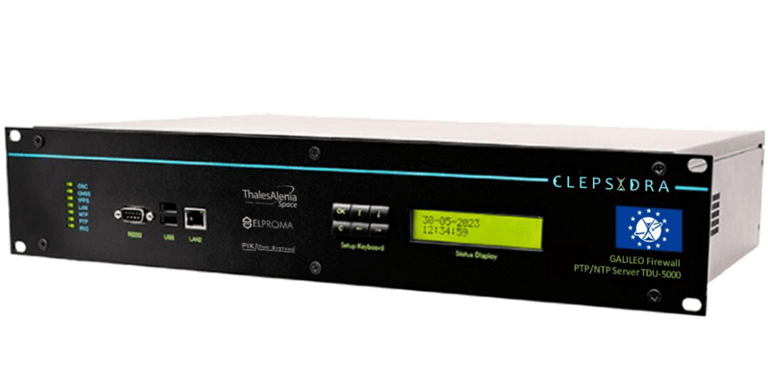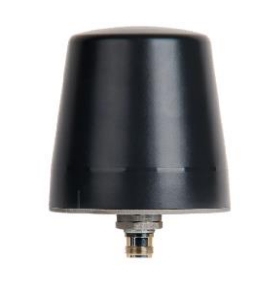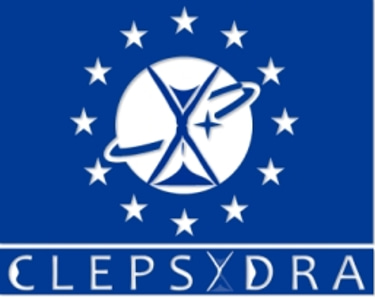Smart innovation Pure design Absolute precision
The CLEPSYDRA Unit embodies European technological excellence, a fusion of industrial-grade design, reliability, and engineering precision in a compact, high-performance solution.


Product overview
High-precision timekeeping powered by Galileo technology
CLEPSYDRA Architecture overview


The CLEPSYDRA Timing Receiver Platform will provide a robust, scalable, flexible and certified high performance GNSS Multi-constellation/Multi-signal receiver for precision T&S applications
Housed in a standard 19”x 2U chassis
GNSS Signal Interface
The system integrates a multi-frequency GNSS antenna and RF cable that also powers the active antenna front-end.
An antenna is selected to meet the requirements of multiple applications, ensuring reliability and compliance with international standards.


GNSS Receiver Core
The GNSS receiver is capable of tracking and processing all major constellations and signals, including Galileo (E1, E5a/b, E6), GPS (L1, L5), and EGNOS (L1/L5).
It features advanced jamming, spoofing, and multipath detection and mitigation to guarantee data integrity and precision.
Time Generation & Distribution Core
At the heart of Clepsydra, this subsystem generates and distributes precise timing signals and reference frequencies to connected devices and networks.
Key capabilities




Redundancy and failover
Accurate time and frequency outputs


Flexible connectivity


Monitoring and diagnostics
Why timing accuracy matters
Timing = Trust


Why It Matters: Precision, Trust, and Security
In the financial sector, timing discrepancies can lead to transaction delays, data mismatches, and loss of regulatory compliance. GPS interference, spoofing attacks, or network drift can compromise the accuracy of timestamps, undermining both transparency and trust. From a cybersecurity standpoint, time manipulation is a subtle but powerful vector: attackers can falsify logs, disrupt forensic trails, and break authentication mechanisms that depend on exact timing
The Risks: From Data Integrity to National Security
Timing failures extend beyond IT. In critical infrastructure like energy systems, poor synchronization can cause phase mismatches or even grid instability. Inaccurate time, in short, isn’t just a technical flaw, it’s a systemic vulnerability
Time Synchronization as a Hidden Infrastructure Backbone
Accurate time synchronization is an invisible but critical foundation of today’s digital world. Financial transactions, data logging, cybersecurity protocols, and even power grid stability all rely on systems being perfectly aligned in time. When these systems fall out of sync, even by milliseconds, the consequences can ripple across industries.
CLEPSYDRA: The Secure Core of Synchronized Operations
CLEPSYDRA addresses the growing risks of inaccurate time synchronization by providing a secure, resilient, and verifiable timing infrastructure.
Its solution combines multi-source synchronization, integrating GNSS, terrestrial networks, and local atomic references, with advanced anomaly detection and cryptographic timestamping to guarantee precision even under disruption or attack. By ensuring continuous, traceable, and tamper-proof timing, Clepsydra protects critical systems such as financial networks, telecom operators, and energy grids from the cascading effects of time drift. In essence, CLEPSYDRA transforms time from a potential point of failure into a foundation of trust, continuity, and operational resilience
Frequently asked questions
How does CLEPSYDRA work?
Who is CLEPSYDRA designed for?
What is the precision?
CLEPSYDRA provides highly accurate and stable time signals with uncertainties below 20 nanoseconds, complying with Service Level 2 of the new Galileo Timing Service. It offers short-term stability up to 5×10⁻¹² seconds at 1-second averaging, and maintains synchronization for extended periods during holdover conditions.
The combination of European-manufactured oscillators, multi-constellation GNSS tracking, and anti-jamming and anti-spoofing capabilities ensures traceable, secure, and robust time synchronization for critical infrastructures such as energy grids, financial systems, and telecommunication networks
CLEPSYDRA is a Galileo-based dual-frequency timing receiver designed to provide accurate and resilient time and frequency references. It receives satellite signals (Galileo, GPS, and EGNOS) through a GNSS antenna and processes them in its GNSS Core, which extracts precise timing data. This information is then managed by the Time and Frequency Core, which generates highly stable outputs, synchronized with Galileo System Time (GST) or UTC.
In case of temporary satellite signal loss, Clepsydra relies on its internal Oven-Controlled Crystal Oscillator (OCXO) or optional Rubidium oscillator, ensuring continuous, drift-free operation
CLEPSYDRA targets critical infrastructure operators, including energy distribution networks, telecom service providers, financial institutions, and transport systems, that require ultra-precise and secure time synchronization. Its Galileo certification, resilience to interference, and modular design make it ideal for both operational and metrological environments
